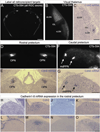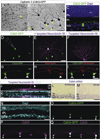Cadherin-6 mediates axon-target matching in a non-image-forming visual circuit
- PMID: 21867880
- PMCID: PMC3513360
- DOI: 10.1016/j.neuron.2011.07.006
Cadherin-6 mediates axon-target matching in a non-image-forming visual circuit
Abstract
Neural circuits consist of highly precise connections among specific types of neurons that serve a common functional goal. How neurons distinguish among different synaptic targets to form functionally precise circuits remains largely unknown. Here, we show that during development, the adhesion molecule cadherin-6 (Cdh6) is expressed by a subset of retinal ganglion cells (RGCs) and also by their targets in the brain. All of the Cdh6-expressing retinorecipient nuclei mediate non-image-forming visual functions. A screen of mice expressing GFP in specific subsets of RGCs revealed that Cdh3-RGCs which also express Cdh6 selectively innervate Cdh6-expressing retinorecipient targets. Moreover, in Cdh6-deficient mice, the axons of Cdh3-RGCs fail to properly innervate their targets and instead project to other visual nuclei. These findings provide functional evidence that classical cadherins promote mammalian CNS circuit development by ensuring that axons of specific cell types connect to their appropriate synaptic targets.
Copyright © 2011 Elsevier Inc. All rights reserved.
Figures




Comment in
-
Cadherins as matchmakers.Neuron. 2011 Aug 25;71(4):566-8. doi: 10.1016/j.neuron.2011.08.005. Neuron. 2011. PMID: 21867873
References
-
- Berson DM. Albright TD, Masland R. The Senses: A Comprehensive Reference, Volume 1, Vision 1. San Diego, CA: Academic Press; 2008. Retinal ganglion cell types and their central projections; pp. 491–520.
-
- Bowling DB, Michael CR. Projection patterns of single physiologically characterized optic tract fibres in cat. Nature. 1980;286:899–902. - PubMed
-
- Dickson BJ. Molecular mechanisms of axon guidance. Science. 2002;298:1959–1964. - PubMed
Publication types
MeSH terms
Substances
Grants and funding
LinkOut - more resources
Full Text Sources
Other Literature Sources
Molecular Biology Databases

